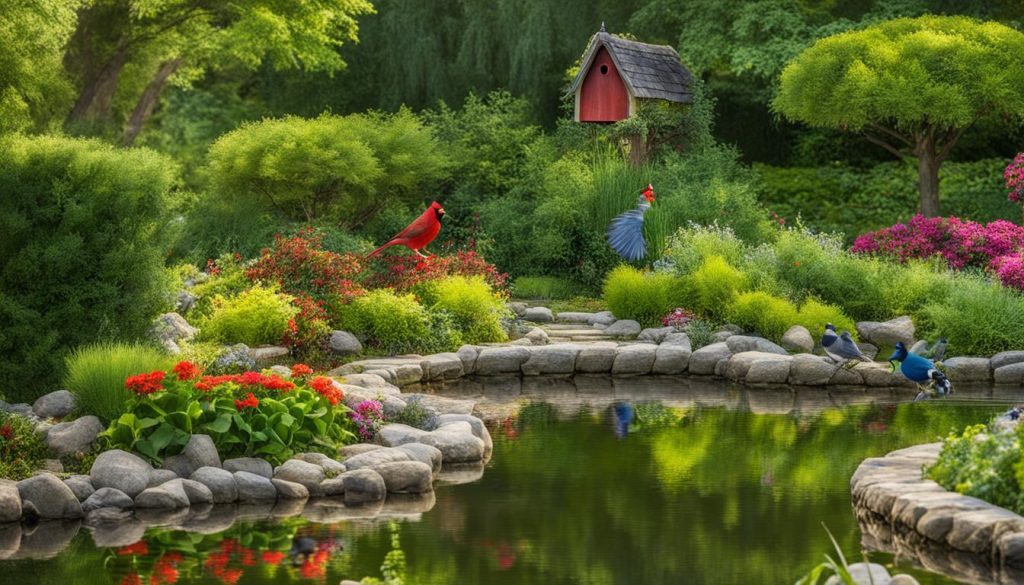Have you ever considered creating a bird habitat in your front yard or backyard? If so, you’re not alone. Canadians have a strong affinity for bird gardens, as they believe in providing a safe home and proper food supplies for them. We understand the importance of cultivating a space where birds can thrive and coexist with us. By incorporating landscaping ideas in your front yard or backyard, we can attract a diverse range of birds to our gardens while enhancing the overall health of the ecosystem.
Bird-friendly landscaping not only benefits the birds but also adds visual appeal and tranquility to your outdoor space. With our expert tips and advice, you can transform your garden into a haven for local bird species while enjoying the beauty of nature. Let’s dive into the world of bird-friendly landscaping in your Canadian garden!
The Importance of Bird-Friendly Landscaping
In Canadian gardens, making landscapes bird-friendly is more than just about looks. It’s vital for helping birds and maintaining nature’s balance. By adding food, water, shelter, and nesting spots, we create a welcoming haven for birds. Birds are facing challenges like losing their habitats and changes in weather, so it’s crucial to lend them a hand. We truly appreciate those who give space to birds in their yards. Creating bird-friendly gardens not only makes birds feel secure but also keeps nature thriving. It’s like giving them a cozy home where they can eat, drink, and rest. And when birds are happy, it benefits the entire ecosystem, keeping everything in harmony and healthy.
As we mentioned earlier, bird-friendly landscaping is important for conservation efforts. By providing food, water, shelter, and nesting sites for birds, we can help mitigate some of the impacts of habitat loss and fragmentation. In addition to this, we can support the overall health of our environment by maintaining the ecological balance through the presence of bird populations.
- Supporting bird populations is important for pollination, seed dispersal, and insect control
- By incorporating bird-friendly landscaping techniques, we can create an inviting habitat for birds and support their overall health and well-being
- Protecting bird populations through landscaping is crucial for maintaining the natural balance of our environment
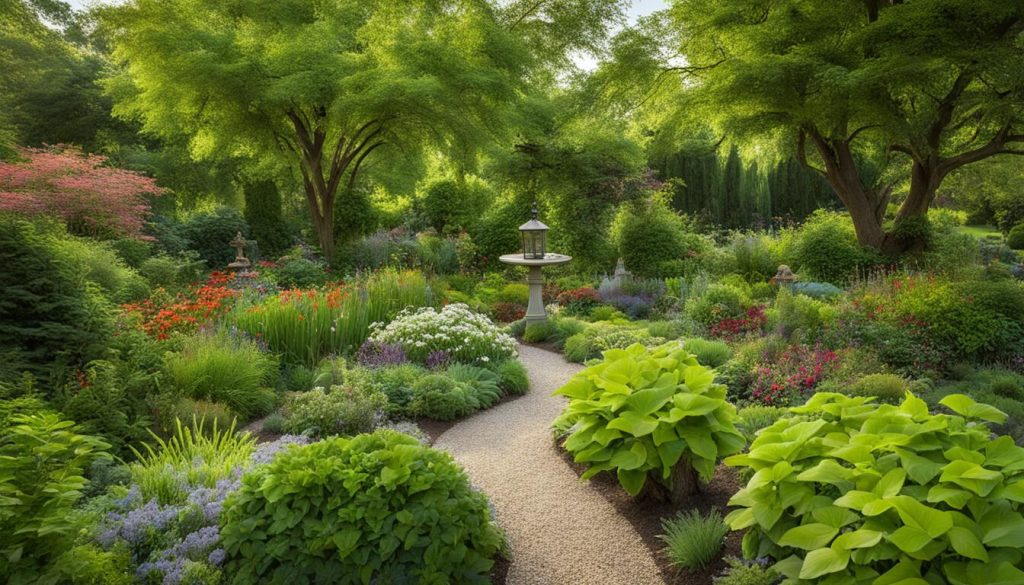
Choosing Native Plants for Bird Habitat
Native plants are essential to creating a bird-friendly habitat. They have adapted to your local climate and soil conditions, providing nesting sites, food, and shelter for birds that are native to your region. Choosing native plants will help to support the overall biodiversity of your garden.
When selecting native plants for your bird habitat, consider the variety of plants that bloom at various times of the year, providing a continuous source of nectar, seeds, and berries throughout the seasons. This ensures that birds have a reliable food source throughout the year.
Some popular native bird loving in Canada include:
- Mulberry
- Creeping Bellflower
- Common Lilac
- Purple coneflower
- Wild Bergamot
- Eastern Red Cedars
- Virginia Creeper
- Serviceberry
- Sunflower
- Milkweed
- Cardinal Flower
- Brown Eyed Susan (also known as Black-eyed Susan or Rudbeckia)
These plants provide food and shelter for a variety of bird species. Serviceberry produces small fruits that are eaten by robins, thrushes, and waxwings. Purple Coneflower produces nectar for hummingbirds and butterflies. Eastern Red Cedars provide shelter and nesting sites for a variety of bird species, including finches and cedar waxwings. Likewise, each plant is bird loving and fulfilling the purpose of increasing birds’ habitat.
By incorporating bird-friendly plants in your garden, you can create a habitat that meets the needs of birds while also adding beauty and interest to your landscape.
Creating Food Sources for Birds
In this section, we will explore different ways to create food sources for birds in your Canadian garden. By providing the right types of bird feeders and bird-friendly plants, you can offer birds the nourishment they need throughout the year.
Installing Bird Feeders
Installing bird feeders is a simple way to provide birds with a reliable food source. When choosing a bird feeder, look for ones that are durable, easy to clean, and can hold different types of birdseed. The best birdseed to use will depend on the types of birds you want to attract. For example, black oil sunflower seeds are a favorite among many bird species, while finches enjoy nyjer seed.
Place your bird feeder in a visible and accessible location, but also consider positioning it away from potential predators, such as cats. Additionally, be sure to clean your bird feeder regularly to prevent the buildup of harmful bacteria or mold.
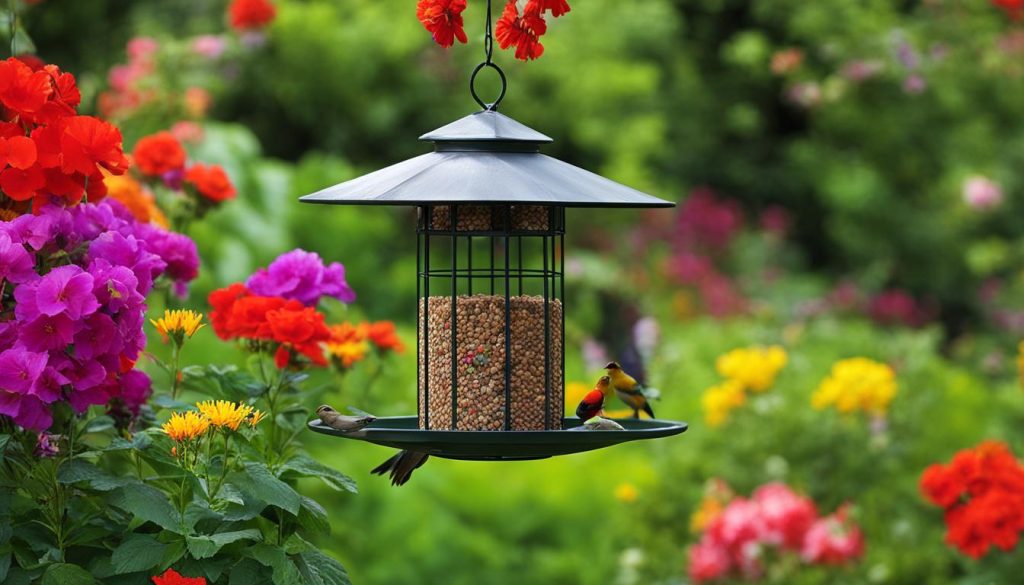
Planting Bird-Friendly Plants
Planting bird-friendly plants is another effective way to attract birds to your garden. Choose native plants that provide food for birds, such as berries, seeds, or nectar. Some excellent options include elderberry, serviceberry, and coneflower.
- Elderberry: Elderberry bushes produce clusters of dark berries that attract a variety of bird species, including cedar waxwings and blue jays.
- Serviceberry: Serviceberry trees produce small, sweet berries that are a favorite among robins, thrushes, and finches.
- Coneflower: Coneflowers produce nectar-rich flowers that attract hummingbirds, bees, and butterflies. The seeds also provide a nutritious food source for finches and other seed-eating birds.
By incorporating bird feeders and bird-friendly plants into your landscape design, you can create a diverse and thriving habitat for birds in your Canadian garden.
Providing Water for Birds
Water sources are essential for birds, and providing them in your garden is an excellent way to attract a variety of species. Not only do bird baths and water features provide drinking water, but they also offer opportunities for birds to bathe, helping them to keep their feathers clean and healthy.
When selecting a bird bath, it’s essential to choose one that is shallow and has a rough surface to prevent birds from slipping. It’s also crucial to keep the water fresh and clean, changing it every few days to prevent the growth of bacteria.
Water features are also popular among birds, and you can easily create a DIY bird-friendly water feature using a simple container and a small pump. Make sure to add some rocks or branches to the container to provide perching spots for birds.
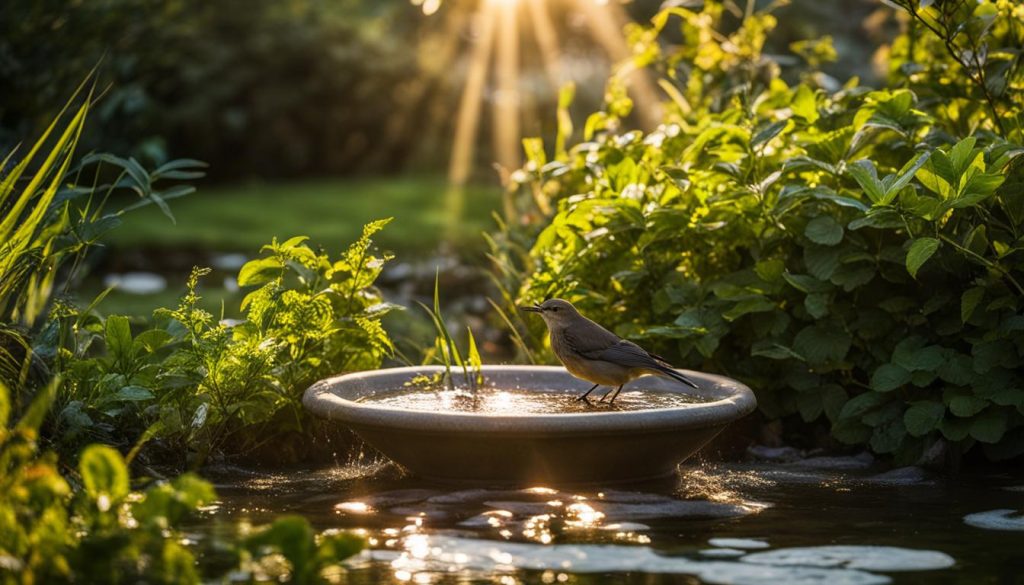
Providing Water in the Winter
Providing water during the winter months is just as crucial as providing it during the warmer months. Consider using a heated birdbath or adding a deicer to your existing bird bath to keep the water from freezing.
Another option is to add a simple heated bird bath to your DIY water feature. Place it in a sheltered area, such as near a bush or tree, to provide protection from the wind and snow.
By providing water sources year-round, you can attract and support a wide variety of bird species in your garden.
Designing Bird-Friendly Structures and Nesting Sites
Creating suitable structures and nesting sites is crucial in bird-friendly landscaping. Birds require a safe and secure environment to raise their young and seek shelter.
Birdhouses and Nesting Boxes
Birdhouses and nesting boxes are essential components of a bird-friendly garden. They provide a safe and cozy space for birds to nest and raise their young. When designing birdhouses and nesting boxes, consider the size and nesting habits of the bird species in your area. Different bird species require different dimensions and entry hole sizes.
When installing birdhouses and nesting boxes, place them in a location that is sheltered from predators and weather elements. Mount them on a pole or post, and at a height that is convenient for maintenance and observation.
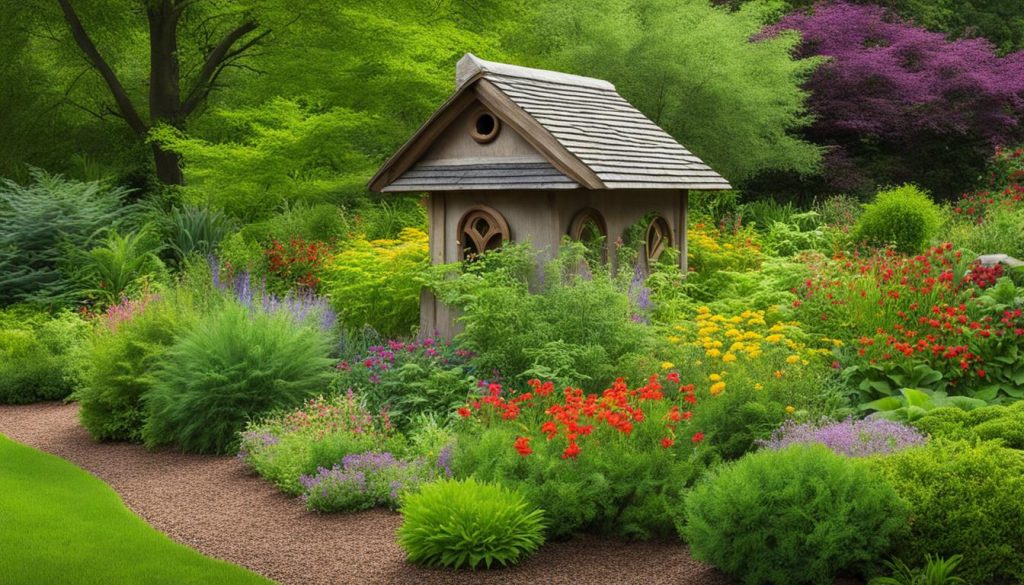
Natural Nesting Sites
Natural nesting sites are another essential element in bird-friendly landscaping. A variety of birds prefer natural structures such as trees, shrubs, and vines to build their nests. When selecting plants for your garden, choose ones that provide a suitable habitat for birds to nest and roost.
Additionally, avoid pruning and trimming your plants during nesting and breeding seasons to provide a secure environment.
By designing suitable structures and incorporating natural features, you can easily create a welcoming environment for birds to call their home.
Managing Pests and Predators in a Bird-Friendly Way
While pests and predators can pose a threat to your garden, it’s crucial to maintain bird-friendly practices when managing them. For instance, using chemical pesticides can harm birds that consume contaminated insects. Instead, opt for natural pest control methods, such as planting companion plants that repel pests or using insecticidal soap.
Another way to manage pests is to discourage their presence by removing any potential habitats, such as tall grass or piles of debris. Keep your garden tidy and well-maintained to reduce the chance of attracting unwanted visitors. If you have a bird feeder, make sure to keep it clean and remove any spilled birdseed or debris that can attract rodents.
When it comes to predators, it’s important to find a balance between protecting your garden and the birds that inhabit it. Building birdhouses or providing suitable nesting sites can help protect birds from predators like cats or squirrels. Additionally, avoid using traps or poisons, as these methods can harm birds and other wildlife.
In summary, managing pests and predators in a bird-friendly way involves using natural pest control methods, keeping your garden tidy, and providing suitable nesting sites for birds. By following these practices, you can help protect both your garden and the diverse bird species that visit it.
Creating a Bird-Watching Haven
Now that your garden is a bird-friendly paradise, it’s time to enjoy the fruits of your labour. Creating a comfortable seating area will allow you to sit back and relax while enjoying the flurry of activity in your garden.
Choose a spot that is sheltered from the wind and sun, and consider installing a bird feeder or bird bath nearby to draw birds closer to your observation area. Having a pair of binoculars handy will enhance your bird-watching experience, allowing you to admire the intricate details of each bird.
Make sure to keep a journal or logbook of the birds you see, noting their behaviour, colours, and unique features. This will help you identify each species and learn more about their habits and preferences.
Expert Tip:
When selecting binoculars for bird-watching, choose a pair with a magnification power of 7 to 10 times and an objective lens diameter of 32 to 40 millimeters. This will provide a clear and bright image without being too heavy or cumbersome to handle.
With a little patience and practice, you can turn your bird-friendly garden into a haven for bird-watching enthusiasts. In no time, you may even spot some rare or unusual species that will make your efforts all the more rewarding.
If you have any questions, our team at Landscaping Vaughan is always happy to help. Reach out today; let’s turn your outdoor space into a stunning, functional masterpiece!

